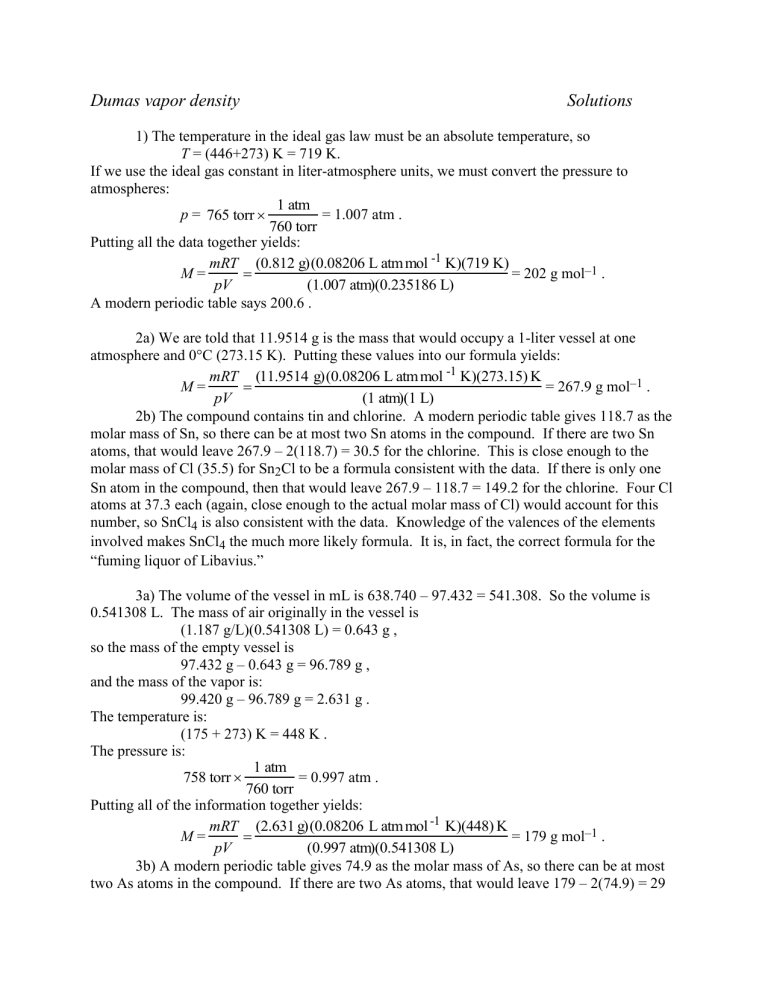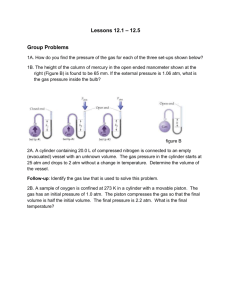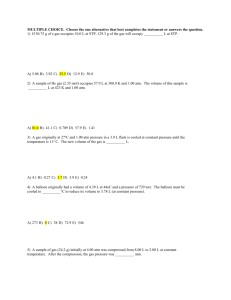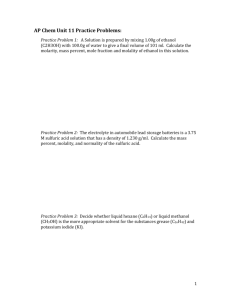dumas - Le Moyne

Dumas vapor density Solutions
1) The temperature in the ideal gas law must be an absolute temperature, so
T = (446+273) K = 719 K.
If we use the ideal gas constant in liter-atmosphere units, we must convert the pressure to atmospheres: p =
765 torr
1 atm
760 torr
Putting all the data together yields:
= 1.007 atm .
M = mRT
(0.812 g)(0.08206 L atm mol
-1
K)(719 K)
= 202 g mol –1 . pV (1.007 atm)(0.235186 L)
A modern periodic table says 200.6 .
2a) We are told that 11.9514 g is the mass that would occupy a 1-liter vessel at one atmosphere and 0°C (273.15 K). Putting these values into our formula yields:
M = mRT
(11.9514 g)(0.08206 L atm mol
-1
K)(273.15) K
= 267.9 g mol –1 . pV (1 atm)(1 L)
2b) The compound contains tin and chlorine. A modern periodic table gives 118.7 as the molar mass of Sn, so there can be at most two Sn atoms in the compound. If there are two Sn atoms, that would leave 267.9 – 2(118.7) = 30.5 for the chlorine. This is close enough to the molar mass of Cl (35.5) for Sn
2
Cl to be a formula consistent with the data. If there is only one
Sn atom in the compound, then that would leave 267.9 – 118.7 = 149.2 for the chlorine. Four Cl atoms at 37.3 each (again, close enough to the actual molar mass of Cl) would account for this number, so SnCl
4
is also consistent with the data. Knowledge of the valences of the elements involved makes SnCl
4
the much more likely formula. It is, in fact, the correct formula for the
“fuming liquor of Libavius.”
3a) The volume of the vessel in mL is 638.740 – 97.432 = 541.308. So the volume is
0.541308 L. The mass of air originally in the vessel is
(1.187 g/L)(0.541308 L) = 0.643 g , so the mass of the empty vessel is
97.432 g – 0.643 g = 96.789 g , and the mass of the vapor is:
99.420 g – 96.789 g = 2.631 g .
The temperature is:
(175 + 273) K = 448 K .
The pressure is:
758 torr
1 atm
= 0.997 atm .
760 torr
Putting all of the information together yields:
M = mRT
(2.631 g)(0.08206 L atm mol
-1
K)(448) K
= 179 g mol –1 . pV (0.997 atm)(0.541308 L)
3b) A modern periodic table gives 74.9 as the molar mass of As, so there can be at most two As atoms in the compound. If there are two As atoms, that would leave 179 – 2(74.9) = 29
for the chlorine. This may be close enough to the molar mass of Cl (35.5) for As
2
Cl to be a plausible formula—or at least a formula consistent with the data. If there is only one As atom in the compound, then that would leave 179 – 74.9 = 104 for the chlorine. Three Cl atoms at 34.7 each (very close to the actual molar mass of Cl) would account for this number, so AsCl
3
is even more consistent with the data. Knowledge of the valences of the elements involved makes AsCl
3 the much more likely formula.
4a) The mass that would occupy a 1-liter vessel at one atmosphere and 0°C (273.15 K) is
8.49 g/L, so:
M = mRT
(8.49 g)(0.08206 L atm mol
-1
K)(273.15) K
= 190 g mol –1 . pV (1 atm)(1 L)
4b) The atomic mass of sulfur is 32, which would make S
6
the formula consistent with
Dumas’ data. Dumas did not have a modern periodic table, but there was a great deal of evidence in his time that the atomic weight of sulfur was 32. At that time, it was not clear whether the molecules of elementary gases were monatomic or diatomic. (Dumas thought they were diatomic.) But no one was prepared to accept a hexatomic molecule!









